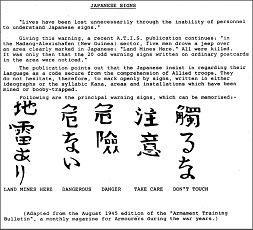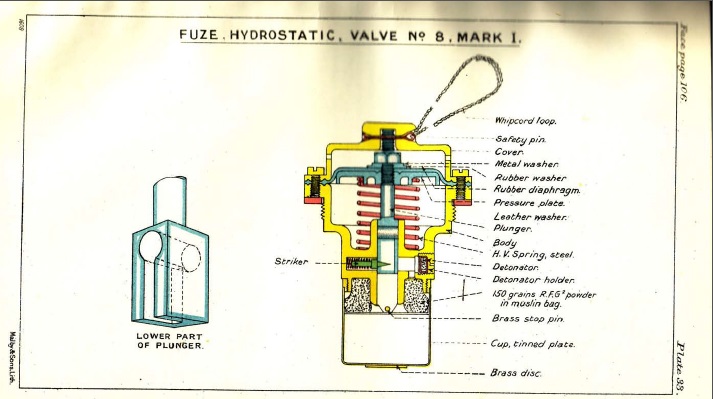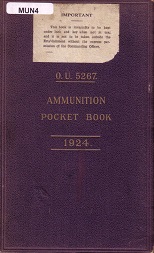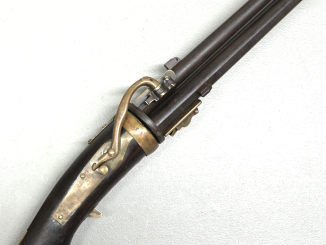We have a couple more ammunition-related documents today, both in English this time (and courtesy of reader Robert). First up is the short one, a 21-page leaflet on Japanese ammunition markings. It was written just after the end of the war, for use by bomb disposal crews to be able to recognize all the various different types of Japanese munitions. The ideal way to handle dummy practice shells is, of course, much different than the ideal way to handle instantaneous-fused HE, and it helps to be able to tell the difference. The document covers everything from aircraft bombs down to basic small arms cartridges, with distinguishing markings of specialty ammo like AP or tracer in both 6.5mm and 7.7mm – could be very handy if you have some WWII-era Japanese ammo.

Second, and perhaps less likely to be directly useful but much more technical and detailed, is a 1924 British booklet (with 1926 addendum; 200+ pages) on ammunition, OU5267. It also covers all manner of ammo, from .22 rimfire training cartridges up to heavy artillery shells, and everything in between (including things like signal flares and depth charges). If it also nicely illustrated, with excellent color cutaway plates of various cartridges, fuses, etc. Like this diagram of a Fuse, Hydrostatic, Valve No.8, Mark I (a depth charge fuse):

If you are at all interested in the state of British munitions in the mid 1920s, you will find this pretty neat, I expect – and it’s interesting to flip through and check out the pretty pictures for everyone else. 🙂





How do we view the second manual? Japanese leaflet and the Ammunition Pocket Book open when you click the pictures, but the other does not. I want to see some pretty pictures! 😉
In Russian equivalent of this books is Альбом конструкций патронов стрелкового и крупнокалиберного автоматического оружия (от 6,5 до 37 мм) from 1946. I suppose that only Russian-language version exists, but it is interesting even if you don’t Russian it is valuable source with many drawings and cross-sections.
I forget: this books also contains info about other countries ammo (for example Germany and Japan).
Cool items 🙂 I bet learning Japanese is quite complicated, looks like write in little pictures rather than letters similar to Chinese, interesting subject have to look into it further one assumes they must sort of suggest something like fire then hand i.e. burnt, not sure. What’s the term Hydrostatic mean, anyone know? Water, friction? In Japanese perhaps you draw a symbol for a waterfall and a head with frizzy hair, who knows. A valve would imply it’s something to do with water also perhaps, I get how the striker would be actuated by the plunger if it was depressed but what depresses it… Water pressure, a depth charge fuze?
Might be something to do with the leather, maybe it contracts when wet.
Oh it is a depth charge fuze, it says so d’oh.
As you deduced, hydrostatic means pressure-activated. But most hydro fuzes have a safety device built in to ensure that they only fire if initiated by water pressure, as opposed to other kinds.
For instance, the WW2 Hedgehog bomb had a contact fuze as opposed to a hydrostatic pressure fuze, so it would only go off if it actually hit a U-boat. But it also had a small “propellor” up front, like an aerial bomb, that only began “unwinding” once it hit the water, to prevent accidental detonation if, for instance, the launcher was fired by mistake at dockside.
According to Gerald Pawle of Admiralty DMWD (in The Secret War), who helped develop the Hedgehog, a Hedgehog launcher was indeed accidentally set off at dockside in New York, lobbing its 20 bombs onto a concrete pier. Every one landed nose first. None detonated.
I think we can safely assume the safety mechanism worked just fine. Of course, I think it is also safe to assume that at least a few people there had to change their underwear rather hastily, as well.
😉
cheers
eon
For sure, underwear change required “it would have all happened so quickly to” he he. Clever weren’t they, all these methods and devices they came up with cheers.
Is the depth charge fuze activated by a vacuum, caused by water pressure out of interest? Is the pressure plate, more sucked in than pressed upon from the outside.
The cover appears to have small holes in it, presumably to let water into a chamber above the rubber diaphragm which appears to be seal the pressure plate in if you will, so perhaps pressurized water squeezes the water inside when it goes lower. To adjust the depth of detonation maybe you screw the nut further down which makes the plungers hole for the striker nearer to it i.e. So the diaphragm would be concave, and the chamber above it larger.
The perforated cover is to protect the diaphragm unit (which is actually a bit delicate) from being hit, kicked, banged into things, etc., on shipboard.
As to how it works, as water pressure on the outside increases, it presses inward on the diaphragm until it goes “pop” inward, like the lid on a Ball canning bottle full of green beans, or whatever, when you take it out of the pressure canner and set it on the counter to cool.
When it goes “pop”, the center of the diaphragm pushes in on the trip of the striker that fires the detonator into the gain, setting off the main charge. Just like an impact fuze on an aerial bomb, except with the diaphragm providing the “impact”.
If you’ve ever watched the movie The Enemy Below, they show the “ratchet” being used to set the depth on the detonator when they begin rolling “ash cans” off the DE’s stern racks. This ratchet adjusts tension on a large coil spring, like the suspension spring on an automobile, that resists the inward pressure of the water on the diaphragm until the “can” is deep enough for the water pressure to overcome the spring.
Submariners learned to listen for the “click”, which was the diaphragm going “pop”, followed by the “BOOM” as the depth charge went off.
As Forest J. Sterling said in Wake of the Wahoo, that “click” could be the loudest noise in the world.
cheers
eon
Aye, I know what you mean eon I think, like the lid off a jar off pickles but inside out sort of thing 🙂
That’s it exactly!
🙂
cheers
eon
Speaking of depth charges, it got me thinking about a relative, my great grandmothers husband who was stepfather to my grandad. He was in the Royal Navy in WW2 and was killed, on HMS Harvester which was sunk in the mid Atlantic during 1943 by a German Submarine in the events described below.
2nd patrol and loss “of the Submarine, Harvester was involved in sinking”
U-444 left La Pallice on 1 March 1943; on the 11th she was sunk in mid-Atlantic by a combination of depth charges and ramming by the British destroyer HMS Harvester and the Free French corvette Aconit.
Forty-one men went down with U-444; there were four survivors.
http://en.wikipedia.org/wiki/HMS_Harvester_(H19)
“Whilst defending Convoy HX 228 on 3 March, Harvester forced U-444 to the surface and then rammed it. She was badly damaged by the ramming, but she rescued the few survivors after the submarine sank. The next day, Harvester was torpedoed by U-432 and broke in half. Nine officers and 136 ratings were lost, but the French corvette Aconit rammed and sank U-432 herself and then rescued Harvester’s few survivors.”
8th patrol and loss “of the submarine which sank Harvester”
U-432 sank HMS Harvester on 11 March 1943 after the British destroyer was badly damaged while ramming U-444. The French corvette Aconit came to Harvester’s assistance. She depth charged and sank the U-boat in mid-Atlantic.
Twenty-six men went down with U-432; there were 20 survivors.
One the plus side the convoy made it…
http://en.wikipedia.org/wiki/Convoy_HX_228
Harvester had already picked up American survivors when she was sunk, in end the French ship Aconit had survivors on it from all.
I wonder what they said to each other.
More information about the engagement,
http://en.wikipedia.org/wiki/French_corvette_Aconit
and indeed about the conversation.
The senior surviving officer of Harvester, Lieutenant J L Briggs (who had been gunnery control officer) interviewed the second-in-command of U-432, who had launched both torpedoes: “Why did you need to fire the second torpedo so shallow? What did you want to do, kill as many as you could?” The oberleutnant replied “didn’t think you were sinking fast enough.”
Charming he he, should have thrown him overboard.
Water pressure compresses the spring which forces the plunger down. Once the pressure becomes high enough the hole in the plunger aligns with the striker which is then forced into the detonator by spring pressure. It’s really quite ingenious when you think about it.
That film in German Das boat is good for imagining being on the other end of this ingenuity isn’t it, don’t fancy it personally. Kind of cool, nearest thing to being on a starship I suppose but just like that your in a alien environment were you can’t breath etc if it goes wrong.
One of my college profs (in Theater Arts- no, really, I did theater) was a retired USN Senior Chief, who spent his entire career in diesel boats. He never got depth-charged (well, that he admitted to – “international incident” if acknowledged, IYKWIMAITYD), being in from the Fifties to the early Seventies, but the possibility was always there, due to the fact that he served on boats that conducted ELINT and similar missions off the PRC.
He said they always knew they were going there because before they left port, the dockside crew would weld steel straps over the well holding the “rescue buoy”- the one with the stencil on the outside saying SUBMARINE SUNK HERE- TELEPHONE INSIDE. (The actual slang term for it among the men who wear the dolphins is the “‘I’m Dead’ Buoy”, for obvious reasons.)
The reason was, as he put it, “When the People’s Liberation Army Navy wants to ‘have a talk’ with you, you don’t want them to know exactly where you are”.
Hm. Now what could cause the buoy to come loose without the lever being pulled in Main Control?
He also likened sub duty to a starship. (Being familiar with “Star Trek”.) Although, as he put it, “We have an advantage over Captain Kirk- we can head for the surface if things get too interesting”.
To do that, the Chief Engineer kicks in all four battery flats on the electric motors running the screws. Normally, you run on two flats, one per shaft. All four cutting in is called “series the batteries”, and is done when you need max turns now.
One time they had a ballast control fault on a test dive off San Diego. The ChEng series’d the flats, and she practically broached like a hooked marlin.
The CO, a freshly-minted LtCMDR from Annapolis, tried to rip the ChEng, a 30-year man, a new one, because the series order is supposed to come from the CO.
ChEng’s response?
“Sir, the batteries are to be series’d when the CO orders it- or when I believe it is necessary .”
Three guesses who the Admiral commanding Sub Group Four sided with. (Note; said Admiral was a “mustang”, and had served with said ChEng both before and after getting frocked.)
😉
cheers
eon
Bit like auto rotating a helicopter but worse by the sounds of it 🙂 The Chinese probably wouldn’t have rung to taunt them, if they sunk, even if they had survived a battle which is unlikely I suppose. Mind you it might have just been annoying because they couldn’t help anyway, not speaking English probably wouldn’t have been an issue as your problem would be self evident he he.
Thanks very much for posting!
Tid bits of info like that are hard to find and a great resource.
A welcome addition to the library.
EJ
Inert-Ord.Net
I’ve been having a read about the WW1 battle of Jutland,
http://en.wikipedia.org/wiki/Battle_of_Jutland
there’s very important information in that wee book.
“To reduce the risk, of sinking”
He he, don’t join the Navy!